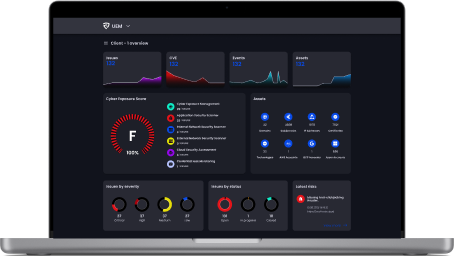



Deserializzazione non sicura
Sebbene questi processi siano fondamentali per gestire i dati in modo efficiente, deserializzazione non sicura comporta rischi significativi per la sicurezza. La deserializzazione non sicura si verifica quando un'applicazione deserializza i dati da fonti non attendibili o manipolate senza un'adeguata convalida. Questa vulnerabilità può essere sfruttata dagli aggressori per eseguire codice arbitrario, manipolare la logica delle applicazioni, accedere a dati non autorizzati o causare attacchi DoS (Denial of Service).
Comprendere la serializzazione e la deserializzazione

La serializzazione e la deserializzazione sono processi essenziali nello sviluppo del software per gestire e trasmettere i dati in modo efficiente all'interno delle applicazioni. Serializzazione trasforma oggetti o strutture di dati complessi in un formato adatto all'archiviazione o alla trasmissione, come JSON, XML o dati binari. Questa trasformazione consente di trasmettere facilmente i dati attraverso le reti o di archiviarli in sistemi di archiviazione persistenti.
Deserializzazione, al contrario, ripristina i dati serializzati nella loro forma oggetto originale all'interno dell'applicazione. Questo processo è fondamentale per ricostruire oggetti di dati da formati serializzati, consentendo alle applicazioni di manipolare e utilizzare i dati nella loro struttura originale.
Esempi reali e case study
L'esame degli incidenti del mondo reale in cui sono state sfruttate le vulnerabilità di deserializzazione non sicure offre informazioni preziose sulla gravità di questi rischi per la sicurezza:
- Caso di studio 1: Impatto della deserializzazione non sicura in un istituto finanziario
- Riepilogo: in questo caso, la deserializzazione non sicura è stata sfruttata per manipolare i dati delle transazioni finanziarie, con conseguenti trasferimenti di fondi non autorizzati e perdite finanziarie.
- Impatto: L'istituto finanziario ha subito significative interruzioni operative e danni alla reputazione a causa della sicurezza violazione.
- Caso di studio 2: incidenti di sicurezza importanti e relative conseguenze
- Riepilogo: Questo caso evidenzia un incidente di sicurezza più ampio in cui più applicazioni in diversi settori sono state vittime di attacchi di deserializzazione non sicuri.
- Impatto: Le conseguenze includevano violazioni dei dati, credenziali utente compromesse e controlli normativi, con conseguenti conseguenze legali e sanzioni pecuniarie.
Impatto della deserializzazione non sicura
La deserializzazione non sicura rappresenta una vulnerabilità critica nelle applicazioni software, con profonde implicazioni per la sicurezza e l'integrità operativa. Quando i dati serializzati vengono convalidati in modo improprio prima della deserializzazione, gli aggressori possono sfruttare questa debolezza per eseguire codice arbitrario, manipolare dati sensibili o lanciare attacchi DoS (Denial of Service). L'impatto di una deserializzazione non sicura può essere devastante, con perdite finanziarie e sanzioni normative, danni alla reputazione e interruzioni operative. Comprendere queste potenziali conseguenze è essenziale per le organizzazioni per dare priorità alle pratiche di codifica sicure e implementare strategie di mitigazione efficaci contro questa minaccia pervasiva.
Strategie di mitigazione
La mitigazione dei rischi associati alla deserializzazione non sicura richiede misure proattive e il rispetto di pratiche di codifica sicure. Gli sviluppatori possono implementare le seguenti strategie per migliorare la sicurezza delle applicazioni:
- Convalida degli input e sanificazione dei dati: Implementa rigorosi controlli di convalida per verificare l'integrità e l'autenticità dei dati serializzati prima della deserializzazione. Assicurati che vengano elaborati solo input di dati affidabili, mitigando il rischio di payload dannosi.
- Utilizzo di librerie o framework di deserializzazione sicuri: Utilizza librerie o framework di deserializzazione affidabili e sicuri che impongono solidi controlli di sicurezza. Queste librerie spesso includono meccanismi integrati per mitigare le vulnerabilità comuni associate alla deserializzazione.
- Adottare il principio del privilegio minimo: Limita i privilegi e le capacità degli oggetti deserializzati al minimo necessario per la funzionalità prevista. Limitando l'ambito degli oggetti deserializzati, gli sviluppatori possono ridurre il potenziale impatto delle violazioni della sicurezza o degli accessi non autorizzati.
Conclusione
Infine, la deserializzazione non sicura comporta rischi significativi per la sicurezza delle applicazioni e l'integrità operativa. Le organizzazioni devono dare priorità a pratiche di codifica sicure e solide strategie di mitigazione per proteggersi efficacemente da queste vulnerabilità. Comprendendo l'impatto della deserializzazione e dell'implementazione non sicure sicurezza proattiva grazie a queste misure, gli sviluppatori possono salvaguardare le applicazioni, mitigare i rischi potenziali e mantenere la fiducia degli utenti e delle parti interessate.
Pronti a vedere di persona?
Prova tu stesso tutte le funzionalità della piattaforma. Nessun impegno e nessuna carta di credito!




.svg)
.svg)
.svg)
.svg)



.svg)
.svg)
.svg)
.svg)
.svg)
.svg)
.svg)
.svg)
